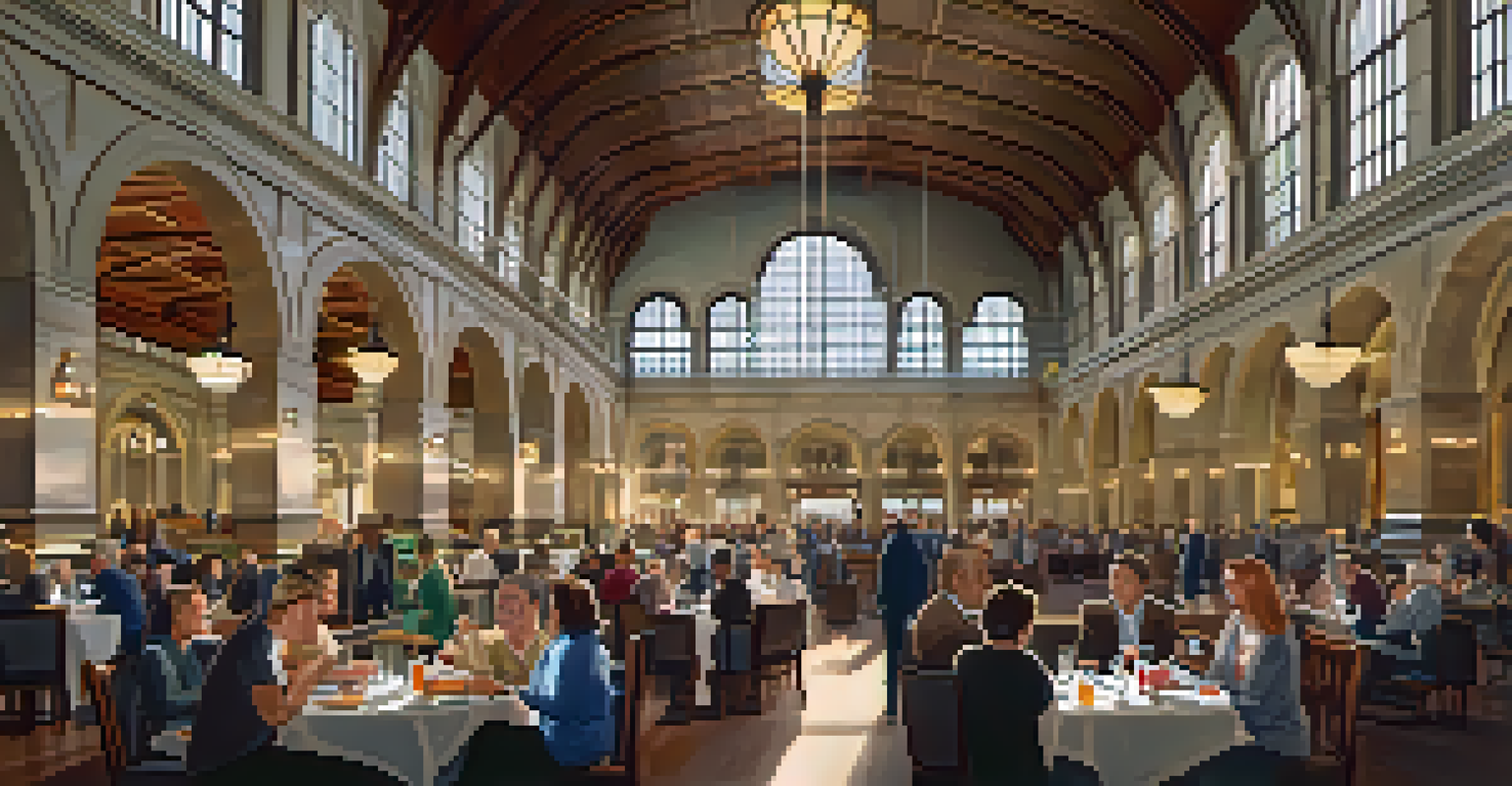The Significance of Denver's Union Station: A Historic Overview

A Brief Introduction to Union Station's History
Denver's Union Station, opened in 1881, has long served as a vital hub for travelers. Originally designed in the Beaux-Arts style, it represented the city's growth during the late 19th century. Over the years, it has evolved from a bustling train station into a modern mixed-use space, reflecting the city's changing landscape.
A train station is a place where journeys begin and end, but it's also a reminder of the history that connects us all.
The station faced challenges, including declining passenger numbers and the rise of cars, leading to its near closure in the 2000s. Thankfully, a dedicated restoration effort in the early 2010s revitalized the station, preserving its historical charm while introducing modern amenities. This revitalization has helped Union Station become a beloved part of Denver's identity.
Today, Union Station is not just a transit point; it symbolizes Denver’s rich history and resilience. It serves as a reminder of the city’s journey through time, showcasing both its past and its vibrant present. Visitors can explore its architectural beauty while enjoying the array of shops and restaurants it houses.
Architectural Significance and Design Features
Union Station's architecture is a stunning example of Beaux-Arts design, characterized by its grand façade and intricate details. The iconic clock tower and the large, arched windows create an inviting atmosphere, drawing in both locals and tourists. These features not only serve aesthetic purposes but also reflect the station's historical importance as a gateway to the West.

Inside, the Great Hall boasts a high ceiling adorned with wooden beams, creating a sense of spaciousness and grandeur. This area has been transformed into a vibrant social space, with a mix of seating areas and eateries that cater to diverse tastes. The juxtaposition of historical architecture with contemporary design elements exemplifies the station’s evolution.
Union Station's Rich Historical Legacy
Denver's Union Station has evolved from a vital rail hub since 1881 to a modern mixed-use space, reflecting the city's resilience and history.
The careful preservation of Union Station's original features, such as the vintage ticket counters and ornate chandeliers, pays homage to its storied past. This blend of old and new attracts architecture enthusiasts and history buffs alike, making it a must-see destination in Denver.
Union Station: A Cultural and Social Hub
Beyond its role as a transit center, Union Station has transformed into a cultural hotspot in Denver. With a plethora of bars, restaurants, and shops, it offers something for everyone. The station regularly hosts events, farmers' markets, and art exhibits, fostering a sense of community among residents and visitors alike.
Preservation of our heritage is not a luxury; it's a responsibility we owe to future generations.
The diversity of offerings at Union Station reflects Denver's vibrant culture and culinary scene. From artisanal coffee shops to fine dining, there’s an emphasis on local flavors and businesses. This commitment to supporting local entrepreneurs has made it a beloved gathering spot for both locals and tourists.
In addition to being a culinary destination, Union Station embraces the arts, featuring local artists and musicians. This dedication to culture enriches the experience for everyone who steps through its doors, creating lasting memories and connections.
The Role of Union Station in Denver's Transportation
Union Station has played a pivotal role in Denver's transportation history, serving as a major hub for rail travel. As train travel became less popular, the station adapted to changing transportation trends, including the introduction of light rail and commuter services. This adaptability has solidified its status as a key player in the region's transit network.
Today, Union Station connects various modes of transportation, including Amtrak, light rail, and buses, making it accessible for commuters and travelers. This integration promotes sustainable transportation options and reduces reliance on personal vehicles, aligning with modern environmental goals. The station is a testament to how transportation can evolve while respecting historical significance.
Cultural and Economic Impact
The revitalization of Union Station has turned it into a cultural hotspot, boosting local commerce and attracting tourists while supporting community spirit.
The continued investment in Union Station and its surrounding infrastructure highlights its importance to Denver's growth. As the city expands, the station remains a focal point for both local commuters and visitors, ensuring its relevance in the ever-changing landscape of urban transportation.
Economic Impact of Union Station on Denver
The revitalization of Union Station has significantly boosted Denver's economy. With its transformation into a mixed-use development, it has attracted new businesses and investments to the area. The influx of visitors and residents has stimulated local commerce, benefiting shops and restaurants nearby.
Moreover, Union Station’s appeal as a tourist destination contributes to the city’s overall economic growth. Tourists flock to the station not only for travel but also for its dining and shopping options. This increased foot traffic has helped revitalize the surrounding neighborhoods, fostering a lively atmosphere.
The economic impact extends beyond just immediate revenues; Union Station has also become a catalyst for urban development in Denver. The area around the station has seen a surge in real estate investments, with new hotels and residential buildings emerging. This growth reflects the station's role in shaping the city's future.
Historical Events That Shaped Union Station
Throughout its history, Union Station has witnessed numerous significant events that have shaped its identity. From its grand opening in 1881 to serving as a troop station during World War II, the station has played various roles in the community. Each chapter in its history adds layers to its rich narrative.
In the late 20th century, Union Station faced challenges as train travel declined, leading to its near abandonment. However, community advocacy and a vision for revitalization brought it back to life, showcasing the importance of preserving historical landmarks. This turnaround is a testament to the dedication of those who believe in the station's potential.
Sustainable Transportation Hub
Union Station serves as a key player in Denver's transportation network, integrating various modes of transit and promoting sustainable travel options.
Today, Union Station stands as a symbol of resilience and community spirit. It has become a gathering place for people from all walks of life, reminding us of the importance of preserving history while embracing the future.
The Future of Union Station: Challenges and Opportunities
As Union Station continues to thrive, it faces new challenges and opportunities in a changing urban landscape. The ongoing development around the station requires careful planning to maintain its historical character while accommodating growth. Striking a balance between preservation and modernization will be key to its future.
The station’s role in sustainable transportation will also evolve as the city’s population grows. Embracing innovative transit solutions and enhancing connectivity will be crucial for meeting the needs of commuters. This adaptability will ensure that Union Station remains a relevant and vital part of Denver's transportation network.

Looking ahead, Union Station has the potential to further enrich Denver’s cultural landscape. Continued investment in community events, art installations, and local businesses can solidify its status as a beloved destination. By nurturing its historical roots while embracing new opportunities, Union Station can thrive for generations to come.